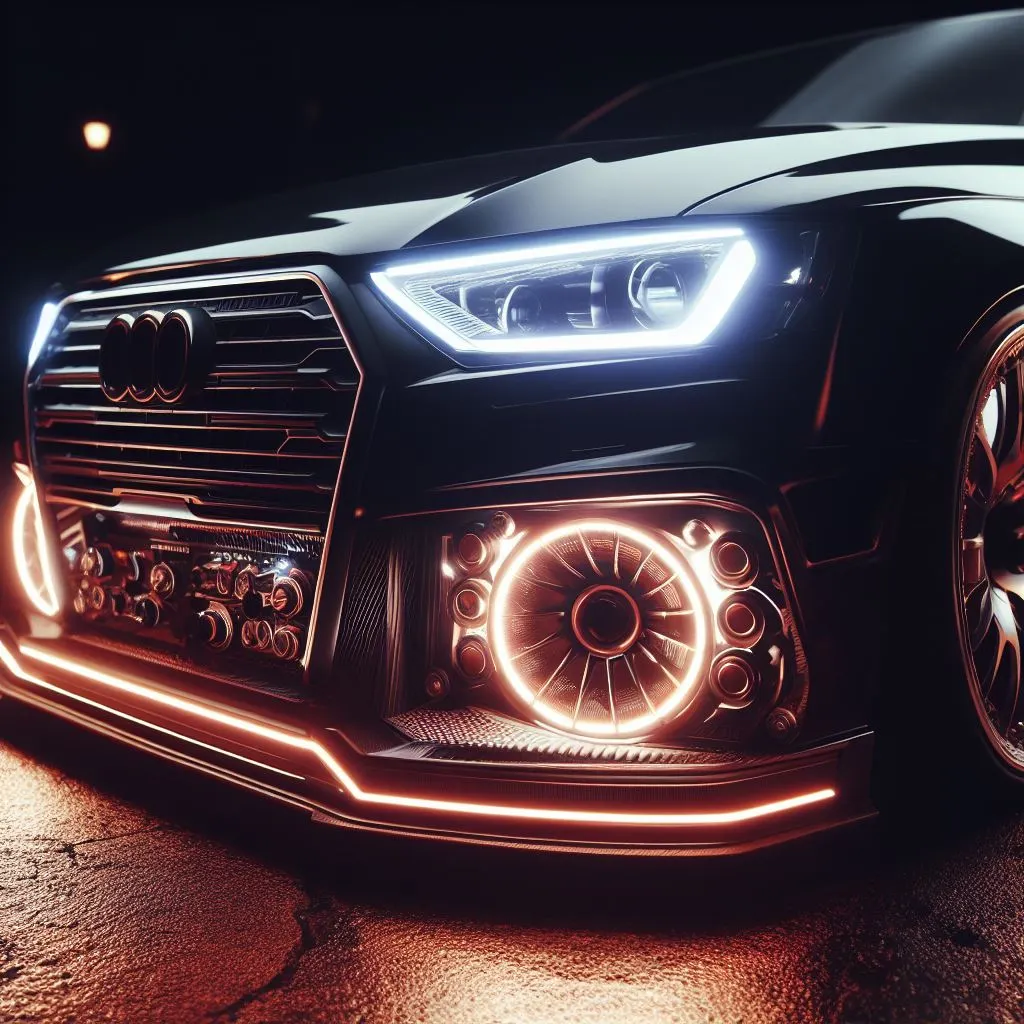Welcome to this guide on LED headlights and amps! In this blog, we’ll discuss the basics of LED headlight technology, types of headlights, and how you can ensure that the correct amount of amps safely power your LED headlights.
We’ll also cover some of the most commonly asked questions about Are LED Headlights Amps and include a checklist to help you choose the right LED headlights for your car.
By the end of this blog, you’ll better understand the various components of LED headlights and amps so you can make an informed decision regarding your car’s lighting needs. Let’s get started!
Explaining LED headlights and the technology behind them
LED headlights are becoming increasingly popular as drivers and car owners look for brighter, more efficient ones. LEDs (Light Emitting Diodes) are a type of semiconductor diode that converts electricity into light.
LED headlights provide a bright white light compared to the traditional halogen bulbs.
LEDs use much less energy than halogen bulbs and are usually built with multiple bulbs within the same unit, making them much brighter than their halogen counterparts. LEDs are also much more efficient, converting up to 60-90% of the energy into light.
This makes them ideal for vehicle lighting applications, as they are significantly more efficient, using a fraction of the energy required by a standard halogen bulb.
The technology behind LED headlights is based on a concept called “pulse width modulation,” or PWM. Pulse width modulation uses a series of pulses to control the brightness of the LED.
The pulse frequency controls the amount of light the LED produces, allowing for very efficient control of the brightness of the light emitted from the LED.
LEDs also have much longer lifespans than halogen bulbs. LED headlights can last between 20,000 and 50,000 hours, while standard halogen bulbs have a lifespan of 1,000 to 2,000 hours. This means that LED headlights can be replaced less often.
Additionally, most LED headlights come with a wide beam angle and are very rugged, making them highly durable and resistant to vibration, shock, and extreme temperatures.
This makes them ideal for automotive lighting applications, where durability is paramount.
LED headlights are also incredibly versatile and can be used in various automotive applications, from headlights and tail lights to fog and auxiliary lighting. Because of their small size can even be mounted in tight spaces, such as in grilles and bumper areas.
Read Also: Can LED Headlights Drain Car Battery? Read + Learn How
Benefits of LED Headlights
LED headlights offer several valuable benefits for drivers. These advantages range from technical aspects, such as improved lighting, to more practical benefits, like a longer lifespan.
- Firstly, LED lights are brighter than traditional halogen bulbs. This means the road is more visible when driving in low-light environments or at night.
- Another benefit of LED headlights is their long lifespan. LED bulbs last much longer than traditional halogen bulbs, which saves time and money on replacements.
- LED headlights also require less electricity than other bulbs, so there is less load on your car’s electrical system. This means you can save on fuel costs due to less electricity.
- Finally, LED headlights are durable and reliable. They resist vibration, extreme temperatures, and other conditions that can cause traditional bulbs to fail.
If safety, performance, and reliability are essential, then upgrading to LED headlights for your car is worth considering.
Types of LED Headlights
LED headlights come in various shapes, sizes, and wattages, allowing for different brightness levels. In addition to the amount of illumination produced, the LED headlight beam pattern is also essential when choosing one.
Most LED headlights come with either a spot beam or a flood beam. Spot beams are more focused and usually will reach further down the road than flood beams. Flood beams cast a more comprehensive light but may not illuminate the road as far ahead.
LED headlights can also be bulb or bar-type headlights. Bulb-type headlights are the most common and are simple bulb replacements.
They are great for replacing ageing stock headlights with a brighter, better-performing option. Bar-type headlights come in a single or double unit and mount directly to the vehicle, often taking up more space than a bulb-type headlight.
In addition, most LED headlights come with a colour temperature. The colour temperature of a headlight is measured in Kelvin (K). LED headlights typically range from 5000K – 6500K.
The higher the number, the more blue/white tinted the light output. Warmer colours range from 3000K to 5000K, while colder colours range from 6000K to 6500K.
Learning about Amps, Voltage and Ohm in LED Headlights
When it comes to LED headlights, it is essential to understand the three components that make up their electrical properties – amps, voltage and ohms. You can choose the best-LED headlight for your car by understanding how each component works.
Amps refer to the amount of current an electrical circuit can handle. At the same time, voltage is a measure of the energy in an electrical circuit, and ohms measure the resistance in the circuit. All three LED headlight components must be considered when choosing the right one for your vehicle.
For instance, when selecting an LED headlight for your car, you must pay attention to the amount of amps it uses. If the LED headlight draws too many amps, it can cause a power surge and damage your car’s electrical system.
On the other hand, if the LED headlight doesn’t draw enough amps, it won’t be able to light up the road efficiently. That’s why checking the amps requirements on the LED headlight before purchasing is essential.
Voltage also plays an essential role in LED headlights. Voltage measures the strength of the multiple electricity sources within a circuit. The higher the voltage, the more influential the LED headlight will be.
However, finding an LED headlight with the right amount of voltage is essential, as too much can also cause a surge and damage your car’s electrical system.
Lastly, ohms measure the amount of resistance in an electrical circuit. Resistance is a circuit’s pushback against the current running through it. The higher the resistance, the less current will flow through the circuit.
When buying an LED headlight, you should look for one with the lowest ohms rating possible to ensure it will provide the most efficient lighting.
Read Also: Don’t Panic! Causes of LED Daytime Running Lights Flicker
Understanding the Dangers of Too Many Amps
Working with LED headlights and their related components can be tricky if one does not understand the concept of Amps, Voltage, and Ohms. When it comes to LEDs, these electrical properties play an essential role in determining the setup’s safety.
Amps refer to the current of electricity that flows through a circuit, while voltage is the force of the current. The electric load, also known as the resistance, is expressed in Ohms. Maintaining a balance between these values is essential for a safe LED headlight installation.
LED headlights are designed to work with a specific amp capacity. If they draw too many amps, they will be damaged and may even cause a fire hazard. This is why the correct amperage must be determined before installing LED headlights.
Understanding the unique requirements of your vehicle’s electrical system before attempting to install LEDs is essential.
For instance, some vehicles use a Pulse Width Modulation System, which regulates the amount of power delivered to the LED headlights to keep them from drawing too many amps.
Additionally, running a low-ohm, high-voltage load may cause the LEDs to overheat and fail. Therefore, it is best to consult a professional technician before installing LED headlights in a vehicle.
Recommended Amps for LED Headlights
LED headlights are a great way to upgrade the lighting in your vehicle, but it’s essential to ensure you get the right amount of amps. The recommended amps for LED headlights range depending on the type of LED lights you’re using and the desired brightness level.
Generally speaking, the average amp draw for LED headlights is .72-1.44 amps. However, when certain additional features are used, this wattage can increase.
For example, some LED headlights come with Daytime Running Light features, for which the amp draw will be higher. The recommended wattage for these headlights ranges between 1.44-2.16 amps.
It’s also important to note that the wattage of an LED headlight assembly depends on the type of components used to construct it. A higher-wattage assembly typically uses higher-quality components, whereas a lower-wattage assembly may use cheaper materials.
When determining the recommended wattage for your LED headlights, it is essential to consider the amount of power your vehicle’s charging system can supply. If you plan to use high-power LED headlights, you need to ensure your charging system can meet its needs.
Guidelines for Safely Using LED Headlights
LED headlights offer a variety of benefits, from being more energy-efficient to providing better visibility. However, LED headlights draw more power than traditional halogen bulbs, so it’s essential to know the safety guidelines when using them. Below are some tips for safely using LED headlights.
- Make sure LED headlights are designed to work with your vehicle’s electrical system. LEDs draw more power than traditional halogen lights, so you must ensure they are adequately rated for your vehicle.
- Check the amperage rating of the LED headlights you plan to use. Amps measure the amount of electricity drawn by the headlight, and if the amperage is higher than what your vehicle’s electrical system can handle, it could cause damage to your car.
- Pay attention to the voltage of the LED headlights. This measures the amount of power supplied to the headlights and must be compatible with your vehicle’s electrical system. Too much or too little voltage can cause damage to the LED headlights and other components in your car.
- Pay attention to the wattage (W) rating on the LED headlight. This measures the power used by the light. If the wattage is too high for your vehicle, it could cause an overload on the electrical system and lead to damage.
- Install the LED headlights according to the manufacturer’s instructions. If the headlights are not installed correctly, it can lead to premature failure of the LED lights due to insufficient airflow or other issues.
When choosing and installing LED headlights, ensuring they are compatible with your vehicle’s electrical system is essential. By following these guidelines, you can ensure your LED headlights provide the optimal performance and safety for your vehicle.
Frequently Asked Questions about LED Headlights and Amps
LED headlights have become increasingly popular due to their efficiency, brightness and long-lasting performance. However, driving with LED headlights requires amps, voltage and ohm knowledge. Here are some commonly asked questions about LED headlights and amps.
What is the difference between Amps, Voltage and Ohms?
Amps (A) measure the amount of electric current in a circuit. Voltage (V) is the force behind the flow of the electric current, while Ohms (Ω) measures the resistance of the circuit to the flow of current.
What does it mean when my LED headlights are drawing too many amps?
If your LED headlights are drawing too many amps, the circuit is overloaded, and the system needs to be adjusted. This could cause a risk of damaging the circuit and the LED headlights.
What is the recommended amp rating for LED headlights?
It is recommended that LED bulbs operate at 0.8 – 2.7 amps. The ideal amp rating depends on your car’s make and model.
What safety guidelines should I follow when using LED headlights?
When using LED headlights, it is essential to ensure that you choose the correct wattage and current draw for your vehicle. Additionally, you should avoid overloading the electrical system by wiring multiple LED headlights together, which can cause overheating.
Conclusion
In conclusion, LED headlights are a fantastic upgrade for any vehicle. They allow drivers to navigate through the night easily, reduce strain on the electrical system, and last many years of reliable service.
Understanding amps, volts, and ohms for LED headlights is essential for maintaining them properly and avoiding danger. With the correct information, you can pick the perfect LED headlight and have a safe experience with your new lights.
This guide helped you learn more about LED headlights and amps. Remember to double-check the recommended amp draw before installing LED lights in your car to ensure safety. Use the checklist at the end of this guide to ensure the LED headlight you choose best fits your needs.
References
When researching and writing about LED headlights and amps, gathering as much accurate information as possible is essential. This helps to ensure a safe and quality experience when installing LED headlights. To that end, the following sources were consulted during the process of creating this guide:
- Battery University: Calculating Power and Energy
- Lifewire: LED Headlight Safety Research
- Motorbeam: LED Headlights Explained
- LED VLEDS: LED Headlights Safety Guide
By using the above sources, readers can be sure they are accessing the most up-to-date and accurate knowledge of LED headlights.
Checklist for Choosing the Right LED Headlight for Your Car
LED headlights are an increasingly popular choice for upgrading your car’s headlights. LED headlights can improve the overall look of your car while providing a brighter, more efficient light source.
However, choosing the right LED headlight can be challenging. Here is a quick checklist to keep in mind when buying LED headlights for your car:
- Price: The price range of LED headlights can vary drastically due to the many different types and brands available. Establish a budget before you start shopping so that you can narrow down your choices.
- Fitment: Different cars may require different types of LED headlights, so check the correct fitment for your vehicle. If you need more clarification, consult with an expert.
- Brightness: LEDs come in a variety of brightness levels. Choose one that meets your visibility needs.
- Colour Temperature: LED headlights usually come in three different temperatures- warm white, natural white, and cool white. Compare each option and pick the one that suits your needs.
- Heat Dissipation: Ensure the LED headlights you buy have proper heat dissipation mechanisms, such as fans or heat sinks, to prevent overheating.
- Compatibility: Research to ensure the LED headlights you choose are compatible with your car’s electrical system.
- Warranty: Look for LED headlights that come with a warranty so that you can be assured of quality and performance.
By considering these points when choosing LED headlights for your car, you can ensure that you get the best lights for your money.
Top 7 FAQs about LEDs and Amps
How do LED headlights work?
LED (Light Emitting Diode) headlights consist of a bulb housing containing a tiny chip containing a diode. When electrical current is applied to the diode, electrons release energy in the form of light.
What are the benefits of LED headlights?
The benefits of LED headlights include an increase in visibility, brightness, durability, longevity, and power efficiency compared to traditional halogen headlights.
What types of LED headlights are available?
There are many types of LED headlights available, including standard replacement bulbs, HID lights, and High Intensity Discharge.
What are LED headlights’ voltage, amps, and ohm?
Voltage refers to the amount of electrical pressure that causes current to flow through a circuit. Amps are the measure of electric current. Ohms refer to the measure of resistance in a circuit.
What is the danger of LEDs drawing too many amps?
LEDs that draw too much current can damage the headlight, resulting in costly repairs. Overloading the current can also cause overheating, which can cause a short or even a fire hazard inside the headlight assembly.
What are the recommended amps for LED headlights?
The general recommendation for LED headlights is to draw no more than .9 amps of current.
What are some guidelines for safely using LED headlights?
A few guidelines for safely using LED headlights include following the vehicle manufacturer’s specifications, choosing the correct wattage based on the bulb being replaced, and not exceeding the recommended amps.





1 thought on “From Watts to Wheels: Are LED Headlights Amps”